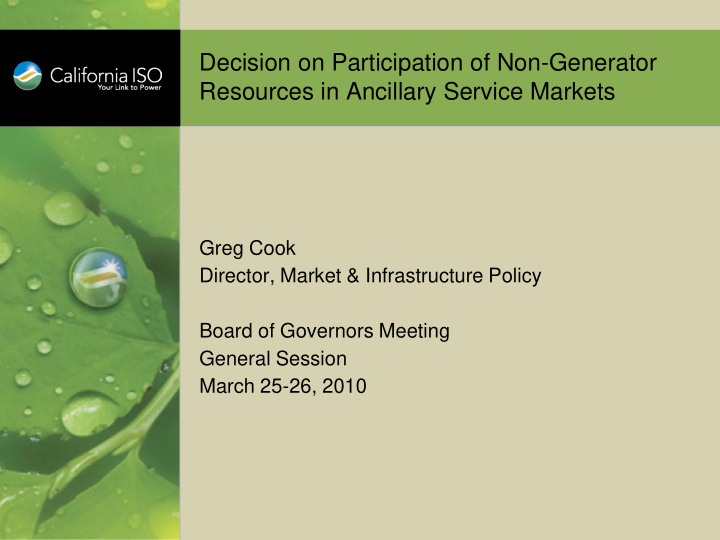



Decision on Participation of Non-Generator Resources in Ancillary Service Markets Greg Cook Director, Market & Infrastructure Policy Board of Governors Meeting General Session March 25-26, 2010
Modifications to existing ancillary service requirements will enable participation of new non-generation resources. Meet requirements of FERC Order Nos. 719 and 890 that directs comparable treatment Important step forward to enable a deeper pool of resources to provide ancillary services Demand response Batteries Flywheels . Slide 2
Proposal aligns ancillary services requirements to current operational needs. Remove resource type restrictions and reduce minimum rated capacity to 500 kW from 1MW Reduce minimum continuous energy requirement from 2 hours to: Spin and Non-Spin – 30 minutes Real-Time Regulation Up/Down - 30 minutes Day-Ahead Regulation Up/Down - 60 minutes Start minimum continuous energy measurement from the period that the resource reaches the awarded energy output Measurement starts once resource reaches awarded energy, not end of 10 minute ramp requirement . Slide 3
Stakeholders support proposed changes, but some argue for additional functionality to address limitations of storage resources. Limited energy storage resources unable to participate in day-ahead regulation market at full capacity Limited ancillary services modifications do not meet the spirit of comparable treatment Example: 20 MW limited 20 MW energy resource 15 MW Regulation 10 MW Up Green – current proposal 5 MW Yellow – manage energy 0 MW 15 30 45 60 Minutes . Slide 4
Further enhancements to ancillary service markets will be addressed this summer. Market and product design review will identify enhancements to accommodate 20% and 33% RPS Pilot projects Test resource capabilities Inform market product design Analyze additional means for participation of non- generation resources New ancillary service products Regulation Energy Management functionality . Slide 5
Management requests Board approval of the proposal. Opens ancillary services markets to all resource types Important step forward to greater participation of storage and demand response resources Deeper pool of resources able to provide spinning and non-spinning Comparable treatment of all technologies based upon ISO operational requirements . Slide 6
Recommend
More recommend